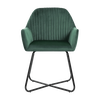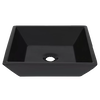Embrace the outdoors with a sun lounger
As summer arrives and the days grow longer, the allure of spending time outdoors becomes irresistible. A sun lounger is an important addition to any outdoor area, offering a comfortable spot to relax and soak up the sun's rays. Whether you're lost in a captivating book, indulging in a refreshing nap, or simply basking in the warmth to boost your vitamin D levels, a sun lounger provides the ideal place to unwind. Versatile and inviting, it transforms your garden, patio, or poolside into a haven of relaxation, making every sunny day more delightful.
Types of sun loungers
When choosing a sun lounger, it's important to consider how you plan to use it. Sun loungers come in various modern and versatile styles to meet different needs. An outdoor sun lounger that fully reclines is ideal for sunbathing, lounging, and relaxing, while a semi-reclined position is great for conversations or reading a book.
-
Folding or fixed: Folding chairs are well-known and popular in many homes and recreation centres. When folded, they occupy less space in your outdoor living area and are easy to transport and store. Conversely, fixed sun loungers take up more space but offer greater stability than their folding counterparts.
-
Fully flat: Fully flat sun loungers, or those that can be adjusted to a flat position, are great for tanning on your stomach. Adjustable models are particularly popular and come in various materials to suit different preferences.
-
S-shaped: As the name suggests, S-shaped sun loungers resemble the letter S. These loungers follow the body's contours, providing better support, especially for those with lower back pain. They are available in a variety of materials.
-
Multi-purpose: Multi-purpose sun loungers are highly versatile, allowing you to lounge in multiple positions, from upright to deep recline. However, most models do not recline fully flat. These loungers often feature large armrests for added comfort.
Choosing the right material for your sun lounger
Sun loungers are available in various materials, each offering unique advantages. The material you choose will impact the appearance of your sun lounger, making it essential to select one that meets your specific needs. Below, we explore the different materials available for your ideal sun lounger.
-
Wood: Wooden sun loungers are typically made from hardwoods like teak, though softwoods can be used if properly treated for outdoor use. Acacia wood is a great alternative to teak, being resistant to dirt and fungi. Wood provides a timeless, natural look and, with proper care, can last for many years.
-
Plastic: Plastic sun loungers are affordable, and easy to clean. They are a popular budget option, though adding removable cushions is recommended for comfort, as plastic can be hard and heats up in the sun. Despite these considerations, plastic loungers remain a stylish and practical choice.
-
Aluminium: Aluminium sun loungers are lightweight, weather-resistant, and strong, typically used for the frame of the lounger. Available in powder-coated or painted finishes, aluminium loungers are easily portable and require minimal maintenance, with no concerns about corrosion.
-
Steel: Steel sun loungers are known for their practicality and sleek appearance. Steel is versatile and fits well in various settings, from patios to poolside areas. Environmentally friendly and easy to maintain, steel loungers are an excellent choice for eco-conscious individuals.
-
Poly rattan: While natural rattan is attractive, it can deteriorate quickly in harsh weather. Poly rattan, or synthetic rattan, offers a weather-resistant alternative that mimics the natural look of rattan. Easy to maintain, poly rattan sun loungers bring a natural aesthetic to your garden and withstand the elements.
-
Polypropylene: Polypropylene, also known as synthetic resin, is a lightweight and long lasting thermoplastic. It's environmentally friendly, chemical-resistant, and ideal for beach areas due to its resistance to salt residues. Polypropylene sun loungers are a versatile and practical choice for outdoor furniture.
-
Fabric: Fabric sun loungers are comfortable and quick-drying. Typically UV resistant, they do not fade in the sun and come in various colours to match any style. Fabric loungers are naturally comfortable without needing additional cushions but may need to be brought indoors in windy conditions.
How to maintain your sun lounger
Like other garden furniture, your sun lounger needs to withstand the elements, which can potentially damage it. While you can't control the weather, there are several steps you can take to keep your garden lounger in excellent condition throughout the year. Here are some care tips for different materials.
-
Wooden material: Hardwood is strong and resilient, suitable for outdoor use all year round, but it still requires maintenance. Clean your wooden sun lounger with a cloth soaked in soapy water, avoiding abrasive or harsh chemicals that can damage the wood. Wipe gently to preserve the wood's natural look, and allow it to dry completely in the sun.
-
Plastic material: Plastic sun loungers can lose colour when exposed to dust, dirt, and bird droppings. Regular cleaning is important. Use a wet cloth soaked in soapy water to clean the lounger, then wipe it down with a dry cloth to remove any remaining water. Plastic loungers can handle more vigorous cleaning compared to wood loungers.
-
Metal material: Metal sun loungers, often painted or powder-coated, need maintenance to stay fresh throughout the year. Clean them with a cloth soaked in mild dishwashing soap, rinse thoroughly, and let them dry. For extra care, apply clear car wax on the surface once a year or repaint the furniture with the same colour paint to keep it looking new.
-
Fabric material: Cleaning fabric sun loungers is similar to cleaning wood, but some fabrics are more delicate and require careful handling. Use warm water mixed with mild washing-up liquid or laundry detergent. Apply the detergent with a clean cloth, wipe the fabric gently, then rinse with clean water to remove the soap. Let the fabric dry naturally in the sun.
Tips for creating a relaxing outdoor area
Transforming your garden into a serene retreat can provide a much-needed escape from the hustle and bustle of daily life. Whether you have a sprawling yard or a cosy balcony, creating a relaxing garden space is all about combining comfort, aesthetics, and a touch of nature. Here are four tips to help you design a tranquil outdoor haven.
-
String lights: String lights can add a magical ambiance to your garden, making it inviting both day and night. Choose warm, soft lights to create a cosy atmosphere. Hang them across a pergola, drape them over trees, or string them along fences to illuminate pathways and seating areas. Solar-powered options are eco-friendly and eliminate the need for extension cords, making installation a breeze. The gentle glow of string lights will enhance the overall mood and make your garden an enchanting place to relax after sunset.
-
Sun loungers: Sun loungers are essential for any relaxing garden setup. They provide a comfortable spot to soak up the sun, read a book, or take a nap. Position your loungers in a sunny area, preferably with a bit of shade nearby for those extra hot days. Opt for adjustable loungers that allow you to switch between sitting and lying down positions. Add a few cushions and a soft throw blanket for added comfort. The versatility and comfort of sun loungers make them ideal for unwinding in your garden.
-
Outdoor furniture: Comfortable outdoor furniture is a must for creating a relaxing garden space. Invest in good pieces that can withstand the elements while providing maximum comfort. Consider a mix of seating options, such as sofas, armchairs, and ottomans, to accommodate various activities. Look for weather-resistant cushions and fabrics that are easy to clean.
-
Plants: Plants are the backbone of any relaxing garden. They add colour, texture, and a sense of tranquillity to your outdoor space. Choose a mix of flowering plants, shrubs, and trees to create a lush, layered look. Incorporate plants with soothing scents, like lavender and jasmine, to enhance the relaxing atmosphere. Use pots and planters to add greenery to patios and balconies. Consider vertical gardens or trellises for small spaces. Regularly tend to your plants to keep them healthy and vibrant, ensuring your garden remains a peaceful haven.
By following these tips, you can create a relaxing garden.






















































































